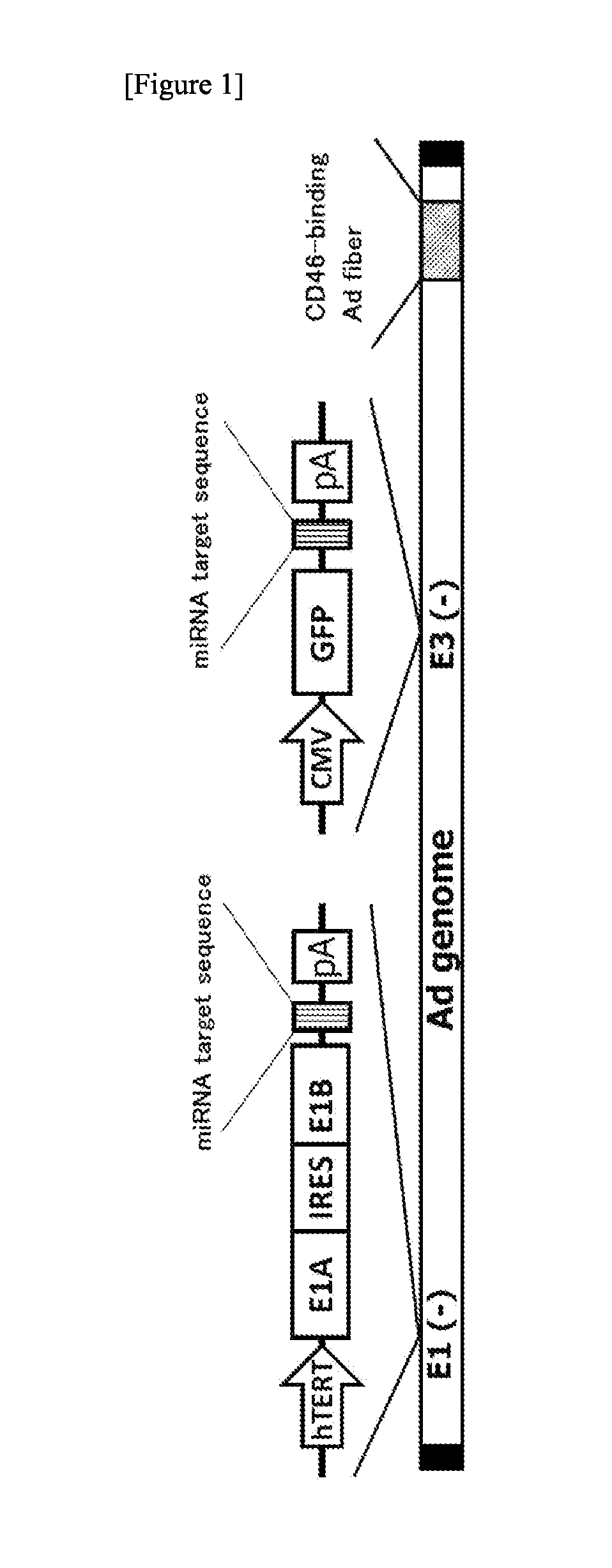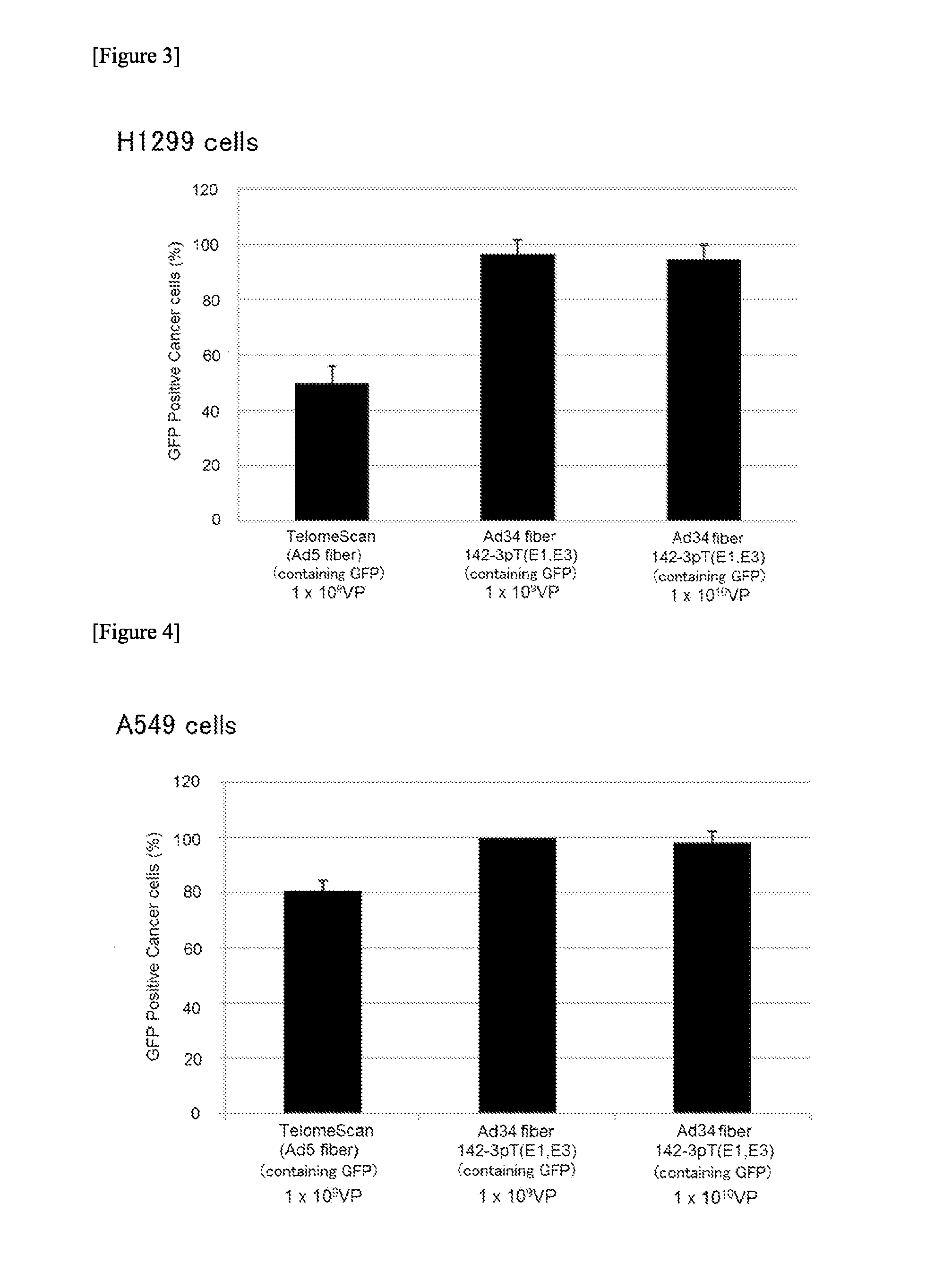Conditionallly replication-competent adenovirus
a technology of adenovirus and adenovirus, which is applied in the field of conditionally replicating adenovirus, can solve the problems of reduced car expression, poor prognosis of patients with ctcs, and risk of systemic metastasis, and achieves the effect of simple and highly sensitive detection
- Summary
- Abstract
- Description
- Claims
- Application Information
AI Technical Summary
Benefits of technology
Problems solved by technology
Method used
Image
Examples
example 1
Preparation of Ad34 Fiber 142-3pT
[0170](1) Preparation of pHMCMV5-miR-142-3pT
[0171]pHMCMV5 (Mizuguchi H. et al., Human Gene Therapy, 10; 2013-2017, 1999) was treated with NotI / KpnI and the resulting fragment was ligated to a double-stranded oligo, which had been prepared by annealing the following synthetic oligo DNAs, to thereby prepare pHMCMV5-miR-142-3pT(pre).
miR-142-3pT-S1:(SEQ ID NO: 43, each underline represents a miR-142-3p target sequence)5′-GGCCTCCATAAAGTAGGAAACACTACACAGCTCCATAAAGTAGGAAACACTACATTAATTAAGCGGTAC-3′miR-142-3pT-AS1:(SEQ ID NO: 44, each underline represents a miR-142-3p target sequence)5′-CGCTTAATTAATGTAGTGTTTCCTACTTTATGGAGCTGTGTAGTGTTTCCTACTTTATGGA-3′
[0172]Then, pHMCMV5-miR-142-3pT(pre) was treated with PacI / KpnI and the resulting fragment was ligated to a double-stranded oligo, which had been prepared by annealing the following synthetic oligo DNAs, to thereby obtain pHMCMV5-miR-142-3pT having 4 repeats of a miR-142-3p target sequence.
miR-142-3pT-S2:(SEQ ID NO:...
example 2
Activity Measurement of Ad34 Fiber 142-3pT(E1,E3)
(1) Cells
[0182]HeLa (derived from human uterine cancer cells) and LN319 (derived from human glioma cells) were used as CAR-positive cells, while LNZ308 (derived from human glioma cells), LN444 (derived from human glioma cells) and K562 (derived from human myelogenous leukemia cells) were used as CAR-negative cells. K562 cells are expressing miR-142-3p. DMEM (10% FCS, supplemented with antibiotics) was used for HeLa, LN319, LNZ308 and LN444 cells, while RPMI-1640 medium (10% FCS, supplemented with antibiotics) was used for K562 cells. These cells were cultured at 37° C. under saturated vapor pressure in the presence of 5% CO2.
[0183](2) Activity Measurement of Ad34 Fiber 142-3pT(E1,E3) by Flow Cytometry
[0184]Cells of each line were seeded in a 24-well plate at 5×104 cells / 500 ul / well and treated with Ad34 fiber 142-3pT(E1,E3) at an MOI of 10. As a control, TelomeScan (i.e., a conditionally replicating adenovirus comprising hTERT promote...
example 3
Detection of Cancer Cells in Blood Samples Using Ad34 Fiber 142-3pT(E1,E3)
[0190]5×104 H1299 cells (CAR-positive) were suspended in 5 mL blood and erythrocytes were lysed to collect PBMCs. To these PBMCs, a virus was added in an amount of 1×109, 1×1010 or 1×1011 VPs (virus particles) and infected at 37° C. for 24 hours while rotating with a rotator. The cells were collected and immunostained with anti-CD45 antibody, and GFP-positive cells were observed under a fluorescence microscope. CD45 is known to be a surface antigen of blood cell lineage cells except for erythrocytes and platelets. “GFP Positive Cancer cells (%)” found in the vertical axis of FIGS. 3 and 4 represents the “number of GFP-positive and CD45-negative cells (%) among GFP-positive cells.”
[0191]As a result, many false positive cells (GFP-positive and CD45-positive cells) were observed upon infection with TelomeScan (Ad5 fiber), whereas false positive cells were very few upon infection with Ad34 fiber 142-3pT(E1,E3), so...
PUM
| Property | Measurement | Unit |
|---|---|---|
| temperature | aaaaa | aaaaa |
| temperature | aaaaa | aaaaa |
| temperature | aaaaa | aaaaa |
Abstract
Description
Claims
Application Information
 Login to View More
Login to View More - R&D
- Intellectual Property
- Life Sciences
- Materials
- Tech Scout
- Unparalleled Data Quality
- Higher Quality Content
- 60% Fewer Hallucinations
Browse by: Latest US Patents, China's latest patents, Technical Efficacy Thesaurus, Application Domain, Technology Topic, Popular Technical Reports.
© 2025 PatSnap. All rights reserved.Legal|Privacy policy|Modern Slavery Act Transparency Statement|Sitemap|About US| Contact US: help@patsnap.com



